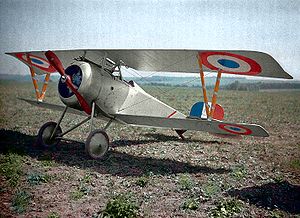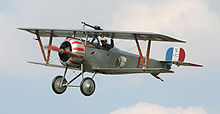Nieuport 17 Video - Classic World War I Fighters
|
|

Role: Fighter
Manufacturer: Nieuport
First flight: January 1916
Introduction: March 1916
Primary user: Aéronautique Militaire
Variants: Nieuport 23
The Nieuport 17 was a French biplane fighter aircraft of World War I, manufactured by the Nieuport company.
Design and development
The type was a slightly larger development of the earlier Nieuport 11, and had a more powerful engine, larger wings, and a more refined structure in general. At first, it was equipped with a 110 hp (82 kW) Le Rhx´ne 9J engine, though later versions were upgraded to a 130 hp (97 kW) engine. It had outstanding maneuverability, and an excellent rate of climb. Unfortunately, the narrow lower wing, marking it as a "sesquiplane" design with literally "one-and-a-half wings", was weak due to its single spar construction, and had a disconcerting tendency to disintegrate in flight. Initially, the Nieuport 17 retained the above wing mounted Lewis gun of the "11", but in French service this was soon replaced by a synchronised Vickers gun. In the Royal Flying Corps, the wing mounted Lewis was usually retained, by now on the improved Foster mounting, a curved metal rail which allowed the pilot to bring the gun down in order to change drums or clear jams. A few individual aircraft were fitted with both guns - but in practice this reduced performance unacceptably, and a single machine gun remained standard.
Operational history
The type reached the French front in March 1916, and quickly began to replace the Nieuport 11 in French service. It was also ordered by the Royal Flying Corps and Royal Naval Air Service, as it was superior to any British fighter at that time. Worthy of note is the fact that during part of 1916, the Nieuport 17 equipped every fighter squadron of the Aéronautique Militaire. The Germans supplied captured examples to several of their aircraft manufacturers for them to copy. This resulted in the Siemens-Schuckert D.I which, apart from the engine installation, was a close copy and actually went into production, although in the event it was not used operationally on the Western Front.
By early 1917, the Nieuport was outclassed in most respects by the latest German fighters. Newer models (the Nieuport 24 and the 27) were brought out in an attempt to retain the type's ascendency. However, the SPAD S.VII had already replaced the Nieuport fighters in many French squadrons by mid-1917. The British persisted with Nieuports a little longer, not replacing their last Nieuport 24bis until early 1918.
Many Allied air aces flew Nieuport fighters, including Canadian ace W.A. Bishop, who received a Victoria Cross while flying it, and most famously of all, Albert Ball, V.C.
Like the other Nieuport types, the 17 was used as an advanced trainer for prospective fighter pilots after its operational days were over.
Variants

Picture - A Nieuport 17 in flight at a display in 2007. Insignia is of the Lafayette Escadrille. Note that this is a scaled-down replica, and not a full size aircraft.
Nieuport 17 Single-seat fighter biplane. Nieuport 17bis Improved version of the Nieuport 17.
Operators
Belgium Chile Colombia Czechoslovakia (Post-war) Estonia
Estonian Air Force
Finland
Finnish Air Force
France Hungary Italy Netherlands Poland Romania Russian Empire Siam (Thailand) Soviet Union
Ukraine United Kingdom
Royal Flying Corps
No. 1 Squadron RFC
No. 14 Squadron RFC
No. 17 Squadron RFC
No. 29 Squadron RFC
No. 40 Squadron RFC
No. 60 Squadron RFC
No. 67 Squadron RFC
No. 111 Squadron RFC
No. 113 Squadron RFC
No. 150 Squadron RFC
United States
Specifications (Nie 17)
Data from Those Classic Nieuports
General characteristics
Crew: one
Length: 5.80 m (19 ft 0 in)
Wingspan: 8.16 m (26 ft 9 in)
Height: 2.40 m (7 ft 10 in)
Wing area: 14.75 m² (158.8 ft²)
Empty weight: 375 kg (825 lb)
Loaded weight: 560 kg (1,232 lb)
Powerplant: 1x— Le Rhx´ne 9Ja 9-cylinder rotary engine, 82 kW (110 hp)
Performance
Maximum speed: 165 km/h (90 kn, 103 mph) at sea level
Endurance: 1.75 hours
Service ceiling: 5,300 m (17,390 ft)
Rate of climb: 11.5 min to 3,000 m (9,840 ft) ()
Wing loading: 37.9 kg/m² (7.77 lb/ft²)
Power/mass: 0.15 kW/kg (0.09 hp/lb)
Armament
Guns:
(French service) 1 x— synchronised Vickers machine gun
(British service) 1 x— Lewis gun on Foster mounting on upper wing
Rockets: 8 Le Prieur rockets
(A few individual aircraft had both guns)
Related development
Nieuport 11
Nieuport 24
Comparable aircraft
Siemens-Schuckert D.I
Bibliography
Bruce, Jack. "Those Classic Nieuports". Air Enthusiast Quarterly. Number Two, 1976. Bromley, UK:Pilot Press. pp. 137-153.
Cheesman E.F., ed. Fighter Aircraft of the 1914-1918 War. Letchworth, UK: Harleyford Publications, 1960.
Cooksley, Peter. Nieuport Fighters in Action. Carrollton, Texas: Squadron/Signal Publications, 1997. ISBN 0-89747-377-9.
Living Warbirds: The best warbirds DVD series.
Source: WikiPedia